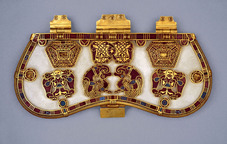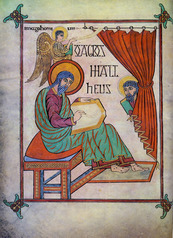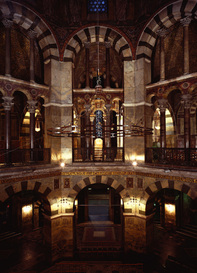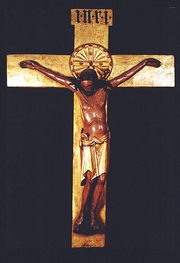Art of the Early Medieval Times (After the fall of Rome - becomes Holy Roman Empire- Europe)
***There were two important events that led to the development of Medieval Europe. One was the Christianization of the Germanic tribes and the second was the unification of Western Europe by Charlemagne.
***This chapter is really about Western medieval Europe from ca. 500-1000CE
***This chapter is really about Western medieval Europe from ca. 500-1000CE
Warrior Lords

Purse Cover from the Sutton Hoo
ship burial in England, ca 625.
- A mixture of Celtic-Germanic culture, Christianity, and the Greco-Roman heritage.
- Abstract decorative design using zoomorphic elements
- In 793 the pagan traders and pirates known as Vikings (named after the viks - coves or "trading places" - of the Norwegian shorelines) set sail from Scandinavia and landed in the British Isles.
- By the eleventh century, much of Scandinavia had become Christian, but the Viking artistic traditions persisted.
- Abstract decorative design using zoomorphic elements
- In 793 the pagan traders and pirates known as Vikings (named after the viks - coves or "trading places" - of the Norwegian shorelines) set sail from Scandinavia and landed in the British Isles.
- By the eleventh century, much of Scandinavia had become Christian, but the Viking artistic traditions persisted.
Hiberno-Saxons

Saint Matthew, Lindisarne Gospels, ca. 698-721
- Most notable artworks from this period are the illuminated manuscripts with detailed and complex patterns and ornamentation of abstract and zoomorphic forms.
- Megalith Celtic crosses of the Irish also had similar patterns.
- In 432 St. Patrick established a church in Ireland and began the Christianization of the Celts on that remote island that had never known Roman rule.
- A style art historians designate as Hiberno-Saxon (Hibernia was the ancient name of Ireland), or sometimes as Insular to denote the Irish-English islands where it was produced, flourished within the monasteries of the British Isles.
- The greatest achievement of Hiberno-Saxon art in the eyes of almost all modern observers is the Book of Kells. This book boasts an unprecedented number of full-page illuminations, including carpet pages, evangelistsymbols, portrayals of the Virgin Mary and of Christ, New Testament narrative scenes, canon tables, and several instances of monumentalized and embellished words from the Bible.
- Megalith Celtic crosses of the Irish also had similar patterns.
- In 432 St. Patrick established a church in Ireland and began the Christianization of the Celts on that remote island that had never known Roman rule.
- A style art historians designate as Hiberno-Saxon (Hibernia was the ancient name of Ireland), or sometimes as Insular to denote the Irish-English islands where it was produced, flourished within the monasteries of the British Isles.
- The greatest achievement of Hiberno-Saxon art in the eyes of almost all modern observers is the Book of Kells. This book boasts an unprecedented number of full-page illuminations, including carpet pages, evangelistsymbols, portrayals of the Virgin Mary and of Christ, New Testament narrative scenes, canon tables, and several instances of monumentalized and embellished words from the Bible.
Carolingians

Interior of the Palatine Chapel of Charlemagne, Germany, 792-805
- Following his coronation as the new Holy Roman Emperor in 800, Charlemagne sought to revive Roman imperial art, culture, and political ideals. Carolingian art consciously emulated Roman models in sculpture and architecture, and sought to revive learning through the increased production of books.
- On Christmas day of the year 800, Pope Leo III crowned Charles the Great (Charlemagne), King of the Franks since 768, as emperor of Rome (r. 800-814).
- Charlemagne encouraged the revival of Classical forms in architecture.
- Charlemagne and his builders were most inspired by the Christian phase of the Late Roman Empire. No Carolingian basilica has survived in anything approaching its original form. Some follow their early Christian models quite closely, while others have a significantly modified basilica plan, converting it into a much more complex form.
- On Christmas day of the year 800, Pope Leo III crowned Charles the Great (Charlemagne), King of the Franks since 768, as emperor of Rome (r. 800-814).
- Charlemagne encouraged the revival of Classical forms in architecture.
- Charlemagne and his builders were most inspired by the Christian phase of the Late Roman Empire. No Carolingian basilica has survived in anything approaching its original form. Some follow their early Christian models quite closely, while others have a significantly modified basilica plan, converting it into a much more complex form.
Ottonians

Crucifix, Germany, ca. 970
- 30 years after the death of Charlemagne and subsequent to the death of his son Louis, the Carolingian Empire was divided between the sons of Louis. (This was the end of the Ottonian Empire) The Frankish lands were partitioned into western, central and eastern, roughly foreshadowing the later nations of France and Germany, and a long strip of land stretching from the Netherlands and Belgium to Rome.
- Only in the mid-10th century did the eastern part of the former empire consolidate under the rule of a new Saxon line of German emperors called the Ottonians.
- The sure lines of Ottonian drapery and flat, clear planes of color seen in the Gospel Book of Otto III are distinctly different from the earlier Carolingian manuscripts.
- Only in the mid-10th century did the eastern part of the former empire consolidate under the rule of a new Saxon line of German emperors called the Ottonians.
- The sure lines of Ottonian drapery and flat, clear planes of color seen in the Gospel Book of Otto III are distinctly different from the earlier Carolingian manuscripts.

